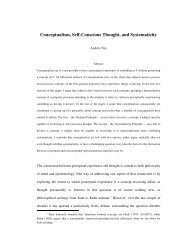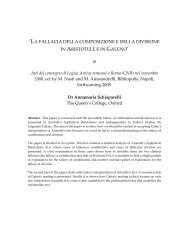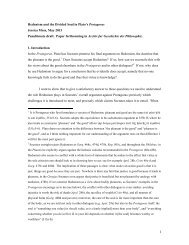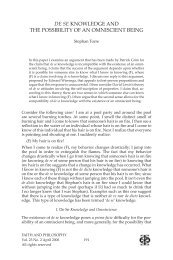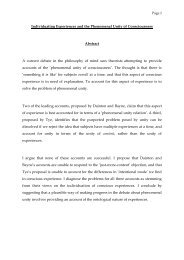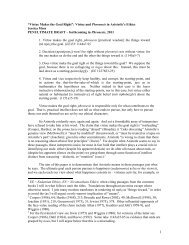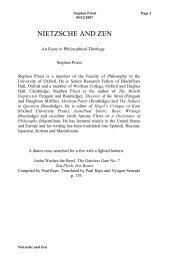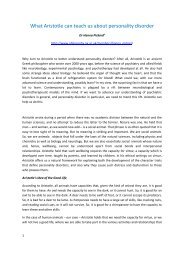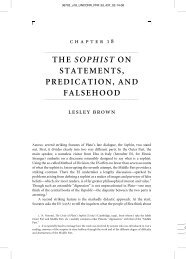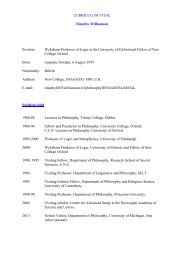Essence and Cause in Plotinus
Essence and Cause in Plotinus
Essence and Cause in Plotinus
You also want an ePaper? Increase the reach of your titles
YUMPU automatically turns print PDFs into web optimized ePapers that Google loves.
type of Aristotelian def<strong>in</strong>ition, i.e., that a def<strong>in</strong>ition has to <strong>in</strong>dicate the essence of the th<strong>in</strong>g<br />
def<strong>in</strong>ed, 20 <strong>in</strong> others he expresses unhapp<strong>in</strong>ess with this type of def<strong>in</strong>ition.<br />
Plot<strong>in</strong>us’ suggestion that <strong>in</strong> some cases a def<strong>in</strong>ition that <strong>in</strong>dicates the essence is not<br />
sufficient may give rise to perplexity. For, when we speak of def<strong>in</strong>itions, we usually dist<strong>in</strong>guish<br />
between conceptual def<strong>in</strong>itions (namely conceptual analyses of the th<strong>in</strong>gs to be def<strong>in</strong>ed) <strong>and</strong><br />
real def<strong>in</strong>itions (namely propositions that give the essences of the th<strong>in</strong>gs to be def<strong>in</strong>ed). It is<br />
well known that both Plato <strong>and</strong> Aristotle seemed to prefer real def<strong>in</strong>itions. Their approach<br />
appears to presuppose that real def<strong>in</strong>itions are the ‘strongest’ ones available. The <strong>in</strong>itial<br />
perplexity can be (at least partly) eased if we consider that Plot<strong>in</strong>us’ conception of def<strong>in</strong>itions<br />
differs from his predecessors’: it depends on his multi-level ontology <strong>and</strong> his own underst<strong>and</strong><strong>in</strong>g<br />
of the notion of logos.<br />
Some of Plot<strong>in</strong>us’ remarks on Aristotelian def<strong>in</strong>itions are expressed <strong>in</strong> a couple of<br />
passages that it is helpful to read. The first is <strong>in</strong> Ennead VI. 7 [38] 4 (that is to say, two chapters<br />
below the texts analysed <strong>in</strong> sections 2-5). The details of Plot<strong>in</strong>us’ overall argument are too<br />
complex to be discussed here, <strong>and</strong> I shall restrict myself to some po<strong>in</strong>ts of <strong>in</strong>terest for our<br />
present discussion. 21 Plot<strong>in</strong>us is try<strong>in</strong>g to answer the question ‘who this man here below is’; he<br />
says that he is look<strong>in</strong>g for the logos of man. Several possibilities are considered. In particular,<br />
he tells us that the composite of soul <strong>and</strong> body cannot be the logos of man. At 16-18, we read:<br />
‘For, this logos will be <strong>in</strong>dicative (dhlwtiko/j) of what is go<strong>in</strong>g to be, not the sort we say man<strong>in</strong>-itself<br />
is, but more like a def<strong>in</strong>ition (oÀr%), <strong>and</strong> the k<strong>in</strong>d of def<strong>in</strong>ition which does not <strong>in</strong>dicate<br />
the essence. For it is not even a def<strong>in</strong>ition of the form <strong>in</strong> matter, but <strong>in</strong>dicates the composite<br />
which already exists’ (Armstrong’s translation revised). 22 The expression ‘def<strong>in</strong>ition that<br />
<strong>in</strong>dicates the essence’ very closely rem<strong>in</strong>ds us of the way <strong>in</strong> which Aristotle characterizes a<br />
def<strong>in</strong>ition. For example, <strong>in</strong> Top. I 101 b 37-8 Aristotle says that a def<strong>in</strong>ition is an account that<br />
<strong>in</strong>dicates the essence (eÃsti d' oÀroj me\n lo/goj o( to\ ti¿ hÅn eiånai shmai¿nwn). In ancient Greek the verb<br />
dhlou=n can have the same mean<strong>in</strong>g as shmai¿ne<strong>in</strong>, namely ‘to <strong>in</strong>dicate’ or ‘to signify’ (LSJ).<br />
Thus, <strong>in</strong> the present passage, it would <strong>in</strong>itially seem that Plot<strong>in</strong>us accepts a strong type of<br />
account (i.e., an account that <strong>in</strong>dicates the essence). However, he later adds that (at least <strong>in</strong> some<br />
cases, e.g., <strong>in</strong> the case of ‘the man here below’) accounts that <strong>in</strong>dicate the essence will not be<br />
adequate: for, <strong>in</strong> these accounts there is no grasp of ‘the formative pr<strong>in</strong>ciple itself which has<br />
made (to\n lo/gon au)to\n to\n pepoihko/ta) for <strong>in</strong>stance man’ (l.25). The notion of logos as<br />
formative pr<strong>in</strong>ciple will be illustrated shortly.<br />
The second passage is Ennead II. 7 [37] 3, 7-10 (it therefore belongs to the treatise that<br />
chronologically precedes Ennead VI. 7). Here Plot<strong>in</strong>us dist<strong>in</strong>guishes between logos as a<br />
def<strong>in</strong>ition that <strong>in</strong>dicates the essence of the th<strong>in</strong>g (o(rismo\j dhlwtiko\j tou= ti¿ e)sti to\ pra=gma) <strong>and</strong><br />
a logos that produces the th<strong>in</strong>g (lo/goj poiw½n pra=gma). It is easy to see that (as <strong>in</strong> the text quoted<br />
above) the expression ‘def<strong>in</strong>ition that reveals the essence of the th<strong>in</strong>g’ is rem<strong>in</strong>iscent of the<br />
20 See, e.g., Top. 130 b 26, APo 73 a 38, Metaph. 1003 b 24.<br />
21 A more extensive discussion of this passage <strong>and</strong> its context can be found <strong>in</strong> Hadot [1988], pp. 207-223.<br />
22 The Greek text is as follows: ãEstai ga\r o( lo/goj ouÂtoj dhlwtiko\j tou= e)some/nou, ou)x oiâoj oÀn famen<br />
au)toa/nqrwpoj, a)lla\ ma=llon e)oikwÜj oÀr%, kaiì toiou/t% oià% mhde\ dhlwtik%½ tou= ti¿ hÅn eiånai. Ou)de\ ga\r<br />
eiãdouj e)stiì tou= e)nu/lou, a)lla\ to\ sunamfo/teron dhlw½n, oÀ e)st<strong>in</strong> hÃdh.<br />
15



